
The bright pink truck with black flames heaves to a halt, the sun illuminating a trailing cloud of dust for a truly ethereal sight. Having heard “truck coming” crackle through the two-way radio from photographer Alastair Brook – hiding in the bushes somewhere – I’ve reversed our 2022 Land Rover Defender 90 test car on to a grassy verge in this remote pine plantation many miles east of Melbourne.
It’s not the first logging truck to come past, but it’s the first one that’s ominously stopped. A stocky, middle-age man with forearms the size of bowling pins climbs from the cab. He’s wearing a mask (surgical, not hockey) so I can’t tell his expression, but it seems he’s not carrying a length of wood full of nails, nor an idling chainsaw. So far, so good.
See, it’s sadly an Australian thing that on a photoshoot, even though you might be breaking no law whatsoever – you might be on public property and not even bothering anybody – often someone must come and tell you to go away. (Irate farmers have even shot at us from a distance with rifles.)
It’s either that, or you’ve got some interesting car and the person approaching is coming over for a friendly chat. But until they open their mouth – are they irrationally, psychotically angry? Or kind and just curious? – you can never really guess which way it’s going to go. The whole mask business has not helped.
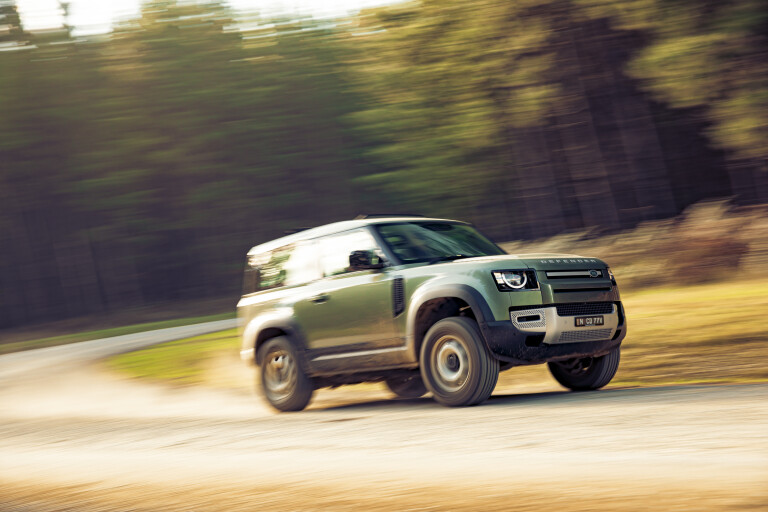
As the man gets closer, I notice he’s wearing a T-shirt emblazoned with – you’re kidding – “70 years of Land Rover”. “Is this the new Defender 90?” he asks somewhat disingenuously, a smile clearly under the mask. I am relieved. He introduces himself as Andrew and says he has a shed-ful of Land Rovers back home – and couldn’t be more curious of our Pangea Green test car.
This encounter could have gone very differently. Spend a bit of time on that most lovely of inventions, the internet, and you’ll find seething nests of Land Rover tragics who, probably in the light of their computer screen late into the evening, in some festering crevasse of Facebook, spew hatred for the new Defender.
The new Defender is crammed with technology to make its forebear look foot-powered and from the Flintstones
The original Land Rover, they argue, was a completely different proposition. In 1948, Rover needed a vehicle to help it through the lean postwar years. The first Land Rover was ostensibly a British Willys Jeep, and quickly became adored by the public for its hose-out utility, reliability and how it shuttled people and goods to places no car had taken them before. Indeed, in making a new Defender, Land Rover may as well have announced it was reinventing the shovel.
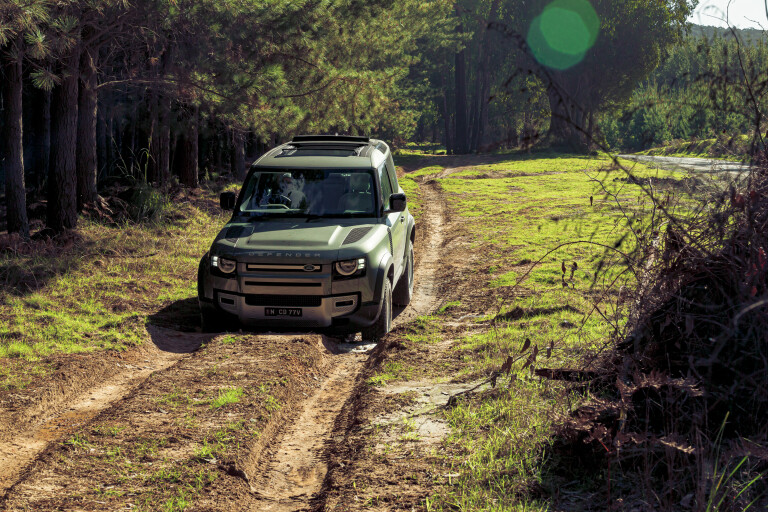
Land Rover made more than two million original Defenders before things like safety and emissions regulations put paid to production in January 2016. In its body-on-frame, dual-solid-axle place came this: the new Defender, on a modern car/SUV platform shared, basically, with Discovery. And crammed with technology to make its forebear look foot-powered and from the Flintstones. Certainly, the wiring loom (looms?) alone would scare the beards off those whose battle-scarred Defenders had taken them to hell and back – back being the operative word.
Today, we hope to do the same (despite mixed reliability reports from owners continuing to curse Jaguar Land Rover). Our vehicle is a Defender 90 S P300 – 90 denoting the shorter wheelbase and two doors; the 300 a nice, round horsepower. Only a decade or two ago, 221kW/400Nm was hold-on-to-your-head-gasket territory for a turbo 2.0-litre four-cylinder. The original 1948 Land Rover also had a petrol inline-4, except its one made about 41kW.
The new engine is a modular unit called the Ingenium AJ200, used widely across the JLR range. In the Defender, it’s stuffed north-south within a modified version of Land Rover’s ubiquitous, aluminium-rich D7 platform underpinning other vehicles like the already mentioned Discovery, but also Velar, F-Pace, Range Rover and Range Rover Sport. For Defender, Land Rover calls it D7x.
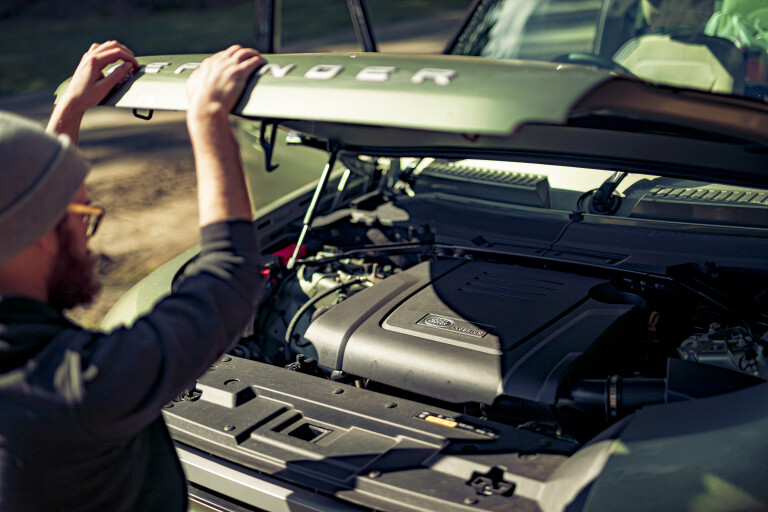
Even before you’re in the presence of the car itself, there’s no getting around the fact the new Defender seems a reimagining for the ever-burgeoning new-age crowd who want people to think they’re planning a trip to the Great Sandy, but would be nervous to find themselves on a dirt road. Certainly, current trends would dictate a solid business case for a retro-styled, short-wheelbase, two-door SUV, from a brand with an increasingly luxury positioning.
While its turbo four-pot works hard for it, 0-100km/h in 7.1sec makes this two-tonne SUV feel as eager as some hot hatches
As such, the criticism – which could all have been avoided if they just gave the car a different name – has come thick and fast. The 18-inch wheels permit larger brakes – and in turn a 3.5-tonne braked towing capacity, as good as any dual-cab ute – but try finding 18-inch tyres in rural Mongolia.
But the new Defender, argues Land Rover, isn’t a Discovery in drag. Its rear payload of 670kg is almost what you’d be proud to fit into the back of a sagging, leaf-sprung old ute; as is its rooftop carrying capacity of 118kg.

This effectively increases the range – important when venturing into the far yonder – as you can pack in more jerry cans. True, too, that the new Defender has some of the best approach and departure angles of any off-roader. And starting at ‘just’ $75K, the new Defender isn’t a total pricing gouge, keeping, admittedly loosely, to the original 1940s principle of affordability.
From the outside, our tester looks the goods to my eyes at least, particularly on those throwback, white 18-inch steel wheels (there are plenty of 18-inch tyres in inner-city Melbourne). The raised ride height, slab-styled front and rear ends, tiny overhangs and square wheelarches give it an almost toy-like appearance.
And there are numerous exterior details to drink in – from the 3D-styled tail-lights to the power bulge on the bonnet, the (plastic) chequer-plate trims, the roof that almost looks chopped and the funky, short-armed wipers. Not since the original Evoke has there been a JLR product so concept-car-for-the-road.
The thoughtful design continues inside. While we didn’t hose it out – although the rubber floors invited as much – Land Rover has achieved a delightful utilitarian feel familiar from the ‘old’ Defender but with a high-tech, luxury touch.

From the driver’s seat, which is quite an effort to get into, the Defender is like sitting on a bar stool in a large cube. It drives with a quirky square footprint, its short wheelbase lending it a surprising sportiness. The coil set-up of our tester feels ‘expensive’ with traceable Range Rover DNA, plenty comfortable around town.
You could be fooled, too, that this petrol 2.0-litre is a diesel. The starter motor sounds like that from a diesel; there’s a subdued clatter at idle, like a diesel. There’s diesel-like torque. If nobody told you, you’d be trying to jam the diesel nozzle into the filler... only if you failed to spot from the driver’s seat the 6750rpm redline.
You might find yourself chasing it often as the Defender is surprisingly fun on a twisty bitumen road. Whereas Toyota, Mercedes and Jeep have not dared mess with the ladder chassis architectures of their 70 Series, Gelandewagen and Wrangler, the Defender’s switch to a monocoque and independent suspension has, predictably, had a transformative effect on its handling.
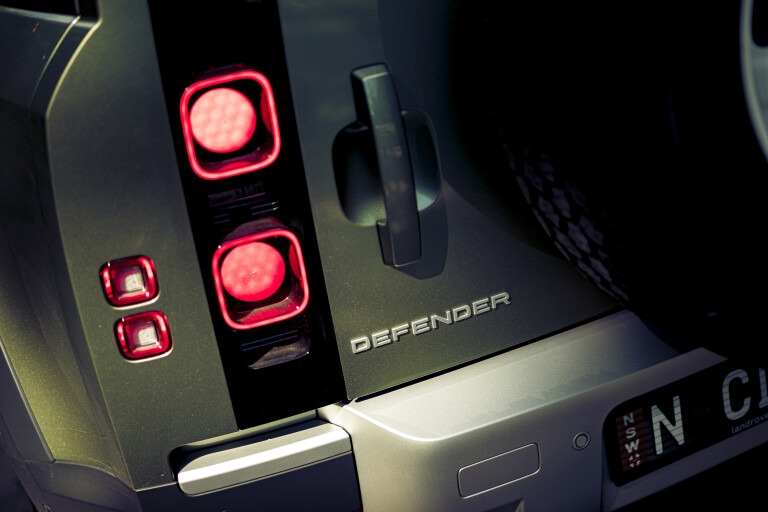
Squat, roll and dive are pronounced, but never loose or uncontrolled, and nursing the heavy, under-tyred Defender through its long suspension arcs as you fang up a twisty road, is a surprising joy. There’s more than a bit of good Jaguar handling nous here, and it certainly feels like a car, not a truck or SUV.
It’s also surprisingly fast. On the famed, serpentine Black Spur Road we must take to reach our pine plantation for photography, the Defender wasn’t a total obstruction to snapper Brook trailing behind in a new, Audi RS6 support vehicle (that’s how we roll at Wheels).
In fact, while its turbo four-pot does work hard for it, the Defender 90’s 0-100km/h claim of 7.1sec makes this two-tonne SUV feel as eager as some hot hatches. For all its supposed off-road chops, the Defender almost fits the textbook definition of a sports car, too: head-turning styling, two doors, a big sunroof and a tiny boot. There’s a bit of fake engine noise you’d want to switch off, but then you wouldn’t hear much at all.
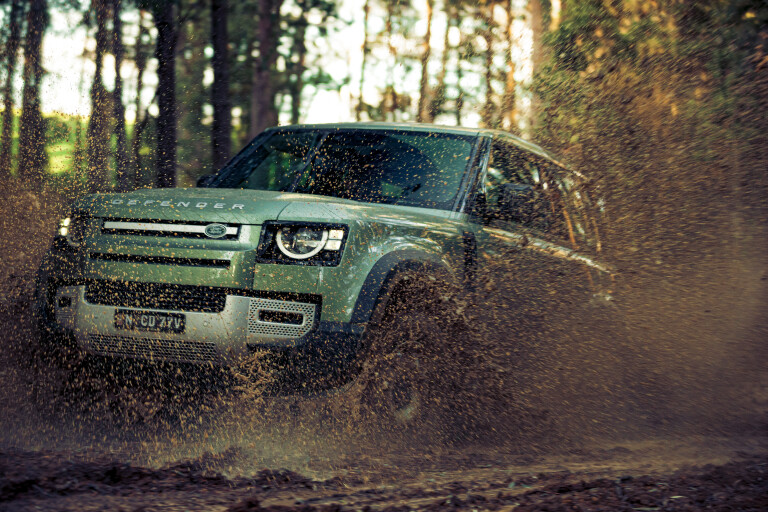
The renowned eight-speed ZF torque-converter auto is also a mastery of response and refinement. While there’s only Eco, Comfort and four off-road modes, at all times it’s silky smooth. There aren’t any shift paddles but the transmission lever can be bumped into manual mode and, pleasingly, it’s push for down gears, pull for up. The Sport transmission mode acts as something of a proto-Sport mode overall.
While the extent of our off-piste proselytising was ploughing through deep puddles that smelt as if numerous animals had disappeared into them, we will have to leave the hardcore stuff and verdict to our mates at 4x4 Australia. Reports from off the beaten track have been largely positive, praising the Terrain Response 2 system that automatically selects drive modes as grip and conditions demand.
There’s obviously low-range and diff locks; and poke your head under the rear guard and the suspension arms are as thick as human arms themselves. The air suspension, which can be raised at the push of a button, is also commended for off-roading – even if with a hint of suspicion given you probably couldn’t fix it without a laptop and a degree in computer science, or at the very least a man in a helicopter.

As we near the end of our time with the Defender 90, it’s hard to figure out what to think of it. Even though there’s a ‘new Defender’, in a way the Defender hasn’t been replaced, it’s been discontinued, and there is a sense of loss.
The old one, too, was unusually classless in a way few cars ever have been. Over in Old Blighty, a Yorkshire shepherd could load a Defender full of hay and feasibly motor past the estate of the local vicar, himself out in his own Defender. If they ever found themselves on either side of a wire fence, despite being from different worlds, they’d have something to talk about.
As is widely known, the Queen has a Defender at Balmoral; Calvin Klein owned one and even Paul McCartney has one in the garage. His 1973 single ‘Helen Wheels’, in fact, was a doting ballad to his vaunted Land Rover (even if it was a play on “hell on wheels”). Yet for so many others, a Defender is simply something of a wheelbarrow with seatbelts.
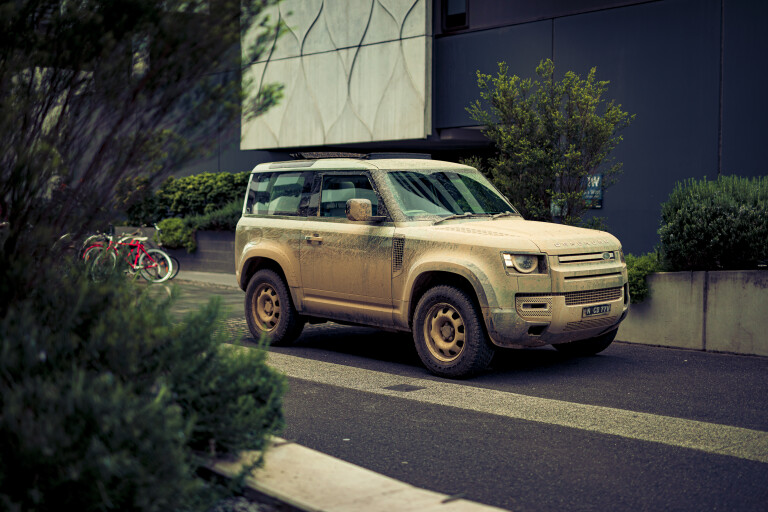
The new Defender, inevitably, feels more for the high end of town. We can’t imagine many old Defender owners replacing it with the new one. If anything, they’re more likely to cling on to the Defender they’ve already got; or buy something like a LandCruiser 70 Series.
If you had to pick between either of those and a new Defender to schlep about town, however, it’s a total no brainer, as the new model excels as a luxury SUV.
One with head-turning styling and a funky rustic safari vibe. And perhaps Land Rover is craftier than we think, as many owners now have the cash to own all three. Perhaps all in a shade of bright pink, with black flames – not to give anybody any ideas.

1. In its Defence
Until 1990, the Defender was simply known as ‘the’ Land Rover, 90 or 110 (for short or long wheelbase). A name wasn’t necessary until Land Rover introduced its second model, the Discovery.
2. Resisting change
The oil change intervals for the Ingenium engine are a staggering 34,000km. JLR says that’s thanks to innovations that lower oil consumption and reduce carbon pollutants reaching the oil, keeping it cleaner for longer.
3. Taking ownership
Land Rover was originally owned by Rover before it was absorbed into
British Leyland Motor Corporation in 1967. It was then bought by BMW in 1994; then Ford in 2001; then by its current owners Tata Motors in 2008.

Dirty Deeds: Ineos Grenadier takes it old school
In replacing the Defender with a modern SUV, Land Rover left the market open for a body-on-frame, dual-solid-axle vehicle. That’s a market that could be filled by the Grenadier, a new Defender tribute produced, unexpectedly, by British chemical manufacturer Ineos.
The Grenadier is coming to Australia in 2022 with BMW-sourced petrol and diesel engines, both 3.0-litre turbo inline sixes, and costing from $84,500. Engineered in conjunction with independent Austrian car manufacturer Magna Steyr, and built in France, Ineos says the Grenadier was conceived by British billionaire owner Sir Jim Ratcliffe over a beer in a London pub. Ineos Australia says it will use Bosch’s network of service centres for local maintenance and warranty work.

Flick the big V: Alternative engine choice brought to the four
In Australia there is the Defender 90 and 110 denoting short and long wheelbases. In either wheelbase you can have a regular one with a back seat, or get the delightful Hard Top which turns your Defender, somewhat randomly, into a two-seat commercial ‘van’.
Land Rover says it harks back to the original Defender Hard Top from the 1950s. As for engines, within the range there is the turbo petrol 2.0-litre of our test car, 3.0-litre petrol and diesel inline sixes and, temptingly, JLR’s sublime supercharged 5.0-litre petrol V8. Sign us up for a V8 Defender 90 we reckon – remember the Bowler Wildcat?
| Model | Land Rover Defender 90 S P300 |
|---|---|
| Engine | 1997cc 4cyl, dohc, 16v, turbo |
| Max power | 221kW @ 5500rpm |
| Max torque | 400Nm @ 1500-4500rpm |
| Transmission | 8-speed automatic |
| Weight | 2140kg |
| L/W/H/W-B | 4583/2105/1974/2587mm |
| 0-100km/h | 7.1sec (claimed) |
| Economy | 15.1L/100km (as tested) |
| Price | $96,478 (as tested) |
| On sale | Now |

COMMENTS